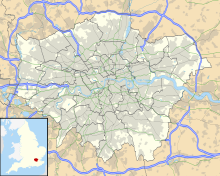
Back مطار لندن بيغين هيل Arabic Aeroport de Biggin Hill Catalan London Biggin Hill Airport CEB Letiště Londýn-Biggin Hill Czech London Biggin Hill Airport Danish London Biggin Hill Airport German فرودگاه لندن بیگین هیل FA Aérodrome de Londres Biggin Hill French ביגין היל (בסיס חיל האוויר המלכותי) HE Aeroporto di Biggin Hill Italian
London Biggin Hill Airport | |||||||||||
|---|---|---|---|---|---|---|---|---|---|---|---|
 | |||||||||||
 | |||||||||||
| Summary | |||||||||||
| Airport type | Public | ||||||||||
| Owner | Regional Airports Limited | ||||||||||
| Location | Biggin Hill, London, England | ||||||||||
| Elevation AMSL | 599 ft / 183 m | ||||||||||
| Coordinates | 51°19′51″N 000°01′57″E / 51.33083°N 0.03250°E | ||||||||||
| Website | bigginhillairport | ||||||||||
| Map | |||||||||||
 | |||||||||||
| Runways | |||||||||||
| |||||||||||
| Statistics (2018) | |||||||||||
| |||||||||||
London Biggin Hill Airport (IATA: BQH, ICAO: EGKB) is a minor commercial airport serving Biggin Hill in the London Borough of Bromley, located 12 NM (22 km; 14 mi) south-southeast of Central London. It specialises in general aviation, handling a spectrum of traffic from private aviation to large business jets. It currently has no scheduled airline service,[3][4] as flights using the airport are not regularly permitted to carry fare-paying passengers.
The airport was formerly a Royal Air Force station RAF Biggin Hill, and a small enclave on the airport still retains that designation. Biggin Hill is best known for its role during the Battle of Britain in the Second World War, when it served as one of the principal fighter bases protecting London and South East England from attack by German Luftwaffe bombers. Over the course of the war, fighters based at Biggin Hill claimed 1,400 enemy aircraft, at the cost of the lives of 453 Biggin Hill based aircrew.[5][6]
The airport has a CAA Ordinary Licence (Number P804) that allows flights for the public transport of passengers or for flying instruction as authorised by the licensee (Regional Airports Limited).
- ^ "Biggin Hill - EGKB". Archived from the original on 16 February 2012. Retrieved 9 December 2008.
- ^ "Data and analysis | UK Civil Aviation Authority". www.caa.co.uk.
- ^ "London Biggin Hill Airport - Welcome". Regional Airports Ltd. Retrieved 4 January 2007.
- ^ "Civil Aviation Authority Aerodrome Ordinary Licences" (PDF). Civil Aviation Authority. Archived from the original (PDF) on 28 June 2007. Retrieved 4 January 2007.
- ^ "London Biggin Hill Airport - Battle of Britain". Regional Airports. Archived from the original on 25 May 2007. Retrieved 4 January 2007.
- ^ "Biggin hill - Battle of Britain RAF Mess Hall at Risk". English Heritage. 10 July 2006. Archived from the original on 26 June 2007. Retrieved 4 January 2007.
